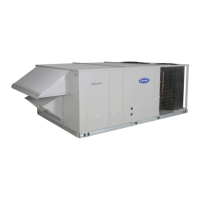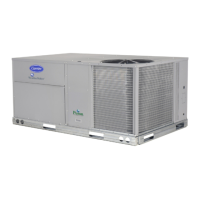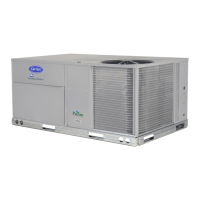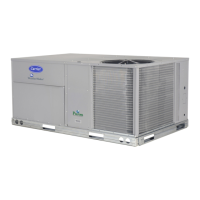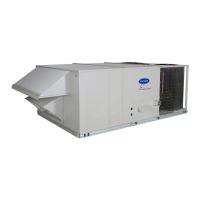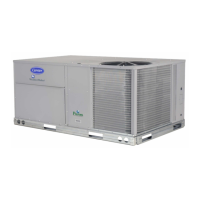49
PRE−START−UP/START−UP
PERSONAL INJURY HAZARD
Failure to follow this warning could result in personal
injury or death.
!
WARNING
1. Follow recognized safety practices and wear
approved Personal Protective Equipment (PPE),
including safety glasses and gloves when
checking or servicing refrigerant system.
2. Do not use a torch to remove any component.
System contains oil and refrigerant under
pressure. To remove a component, wear PPE and
proceed as follows:
a. Shut off all electrical power to unit. Apply
applicable Lock−out/Tagout procedures.
b. Recover refrigerant to relieve all pressure
from system using both high−pressure and
low pressure ports.
c. Do not use a torch. Cut component connec-
tion tubing with tubing cutter and remove
component from unit.
d. Carefully un−sweat remaining tubing stubs
when necessary. Oil can ignite when exposed
to torch flame.
3. Do not operate compressor or provide any electric
power to unit unless compressor terminal cover is
in place and secured.
4. Do not remove compressor terminal cover until
all electrical power is disconnected and approved
Lock−out/Tagout procedures are in place.
5. Relieve all pressure from system before touching
or disturbing anything inside terminal box
whenever refrigerant leak is suspected around
compressor terminals.
6. Never attempt to repair a soldered connection
while refrigerant system is under pressure.
ELECTRICAL OPERATION HAZARD
Failure to follow this warning result in personal injury
or death.
The unit must be electrically grounded in accordance
with local codes and NEC ANSI/NFPA 70 (American
National Standards Institute/National fire Protection
Association.
!
WARNING
Proceed as follows to inspect and prepare the unit for
initial start−up:
1. Remove all access panels.
2. Read and follow instructions on all WARNING,
CAUTION, and INFORMATION labels attached to,
or shipped with, unit.
3. Make the following inspections:
a. Inspect for shipping and handling damages such
as broken lines, loose parts, or disconnected
wires, etc.
b. Inspect for oil at all refrigerant tubing connec-
tions and on unit base. Detecting oil generally
indicates a refrigerant leak. Leak−test all refrig-
erant tubing connections using electronic leak
detector, halide torch, or liquid−soap solution.
c. Inspect all field−wiring and factory−wiring con-
nections. Be sure that connections are completed
and tight. Be sure that wires are not in contact
with refrigerant tubing or sharp edges.
d. Inspect coil fins. If damaged during shipping and
handling, carefully straighten fins with a fin
comb.
4. Verify the following conditions:
a. Make sure that condenser−fan blade are correctly
positioned in fan orifice. See Condenser−Fan
Adjustment section for more details.
b. Make sure that air filter(s) is in place.
c. Make sure that condensate drain trap is filled
with water to ensure proper drainage.
d. Make sure that all tools and miscellaneous loose
parts have been removed.
START−UP, GENERAL
Unit Preparation
Make sure that unit has been installed in accordance with
installation instructions and applicable codes.
IMPORTANT: Follow the base unit’s start-up sequence
as described in the unit’s installation instructions:
In addition to the base unit start-up, there are a few steps
needed to properly start-up the controls. RTU-OPEN’s
Service Test function should be used to assist in the base
unit start-up and also allows verification of output
operation. Controller configuration is also part of start-up.
This is especially important when field accessories have
been added to the unit. The factory pre-configures options
installed at the factory. There may also be additional
installation steps or inspection required during the start-up
process.
Additional Installation/Inspection
Inspect the field installed accessories for proper
installation, making note of which ones do or do not
require configuration changes. Inspect the RTU-OPEN’s
Alarms for initial insight to any potential issues. Refer to
the following manual: “Controls, Start−up, Operation and
Troubleshooting Instructions.” Inspect the SAT sensor for
relocation as intended during installation. Inspect special
wiring as directed below.

